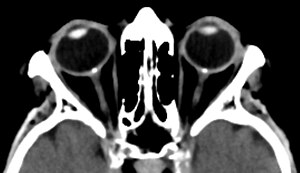Optic disc drusen
| Optic disc drusen | |
|---|---|
 |
|
| Bilateral optic disc drusen in computed tomography seen as dense spots at the optical disc | |
| Classification and external resources | |
| ICD-10 | H47.3 |
| ICD-9-CM | 377.21, 377.24 |
| OMIM | 177800 |
| DiseasesDB | 31338 |
| eMedicine | oph/615 |
| MeSH | D015594 |
Optic disc drusen (ODD) or optic nerve head drusen (ONHD) are globules of mucoproteins and mucopolysaccharides that progressively calcify in the optic disc. They are thought to be the remnants of the axonal transport system of degenerated retinal ganglion cells. ODD have also been referred to as congenitally elevated or anomalous discs, pseudopapilledema, pseudoneuritis, buried disc drusen, and disc hyaline bodies. They may be associated with vision loss of varying degree occasionally resulting in blindness.
The optic nerve is a cable connection that transmits images from the retina to the brain. It consists of over one million retinal ganglion cell axons. The optic nerve head, or optic disc is the anterior end of the nerve that is in the eye and hence is visible with an ophthalmoscope. It is located nasally and slightly inferior to the macula of the eye. There is a blind spot at the optic disc because there are no rods or cones beneath it to detect light. The central retinal artery and vein can be seen in the middle of the disc as it exits the scleral canal with the optic nerve to supply the retina. The vessels send branches out in all directions to supply the retina.
Optic disc drusen are found clinically in about 1% of the population but this increases to 3.4% in individuals with a family history of ODD. About two thirds to three quarters of clinical cases are bilateral. A necropsy study of 737 cases showed a 2.4% incidence with 2 out of 15 (13%) bilateral, perhaps indicating the insidious nature of many cases. An autosomal dominant inheritance pattern with incomplete penetrance and associated inherited dysplasia of the optic disc and its blood supply is suspected. Males and females are affected at equal rates. Caucasians are the most susceptible ethnic group. Certain conditions have been associated with disc drusen such as retinitis pigmentosa, angioid streaks, Usher syndrome, Noonan syndrome and Alagille syndrome. Optic disc drusen are not related to Bruch membrane drusen of the retina which have been associated with age-related macular degeneration.
...
Wikipedia
